Report: Financial Statement Analysis for Gatsby Grange Hotel 2018-19
VerifiedAdded on 2023/01/10
|13
|3167
|40
Report
AI Summary
This report provides a detailed financial statement analysis of Gatsby Grange, a small chain of boutique hotels, for the years 2018 and 2019. The analysis focuses on calculating and interpreting various financial ratios, including profitability (gross profit, net profit, return on assets, and return on capi...

Analysis of the financial
statements
statements
Paraphrase This Document
Need a fresh take? Get an instant paraphrase of this document with our AI Paraphraser

Contents
INTRODUCTION...........................................................................................................................3
TASK 1...................................................................................................................................3
A) Calculation of suitable ratios for the year 2018-19.......................................................3
B) Ratio fluctuation useful for Hotel Management...........................................................8
C) Benefits and limitations of ratios analysis that help to make decision.........................9
TASK 2..........................................................................................................................................12
Covered in PPT.....................................................................................................................12
CONCLUSION..............................................................................................................................12
REFERENCES..............................................................................................................................13
INTRODUCTION...........................................................................................................................3
TASK 1...................................................................................................................................3
A) Calculation of suitable ratios for the year 2018-19.......................................................3
B) Ratio fluctuation useful for Hotel Management...........................................................8
C) Benefits and limitations of ratios analysis that help to make decision.........................9
TASK 2..........................................................................................................................................12
Covered in PPT.....................................................................................................................12
CONCLUSION..............................................................................................................................12
REFERENCES..............................................................................................................................13
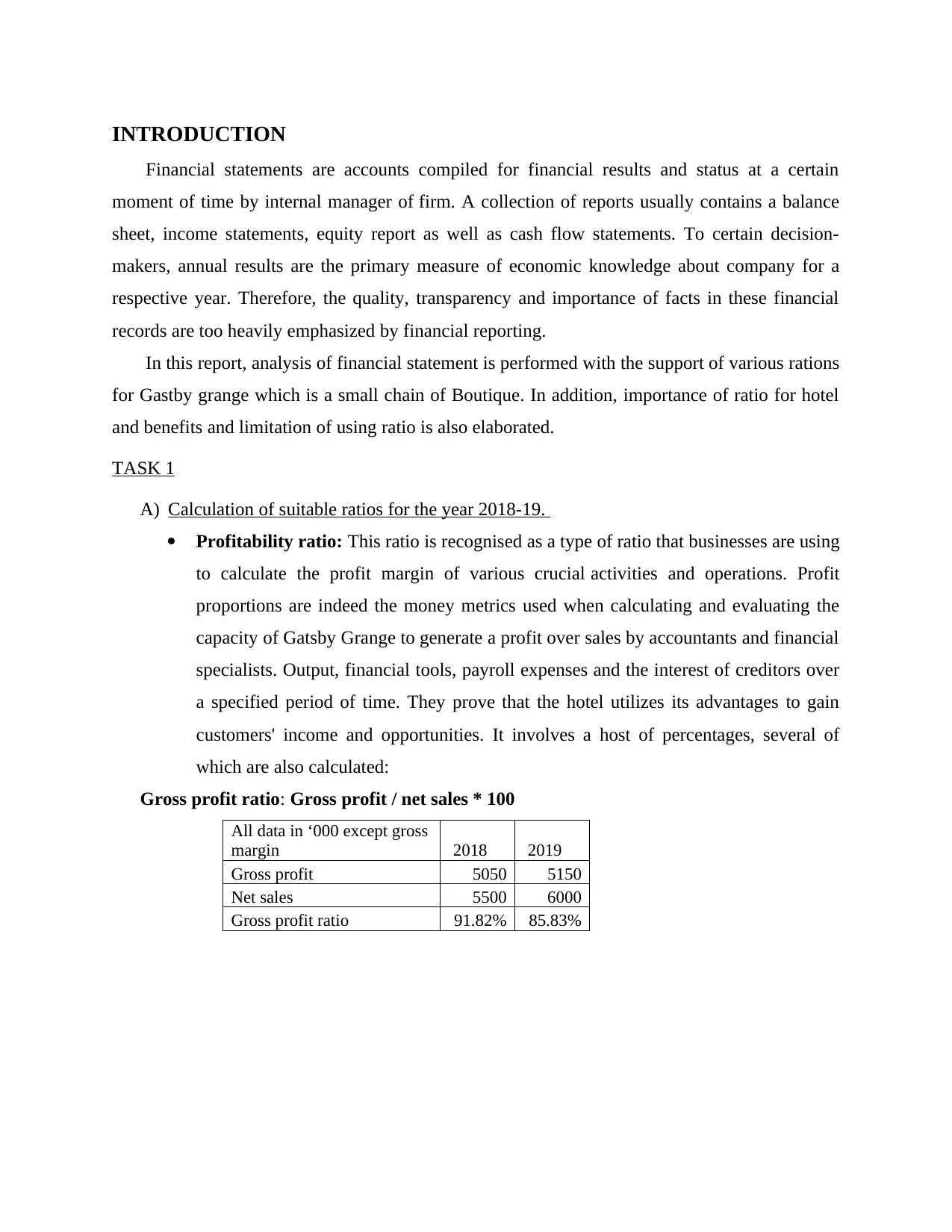
INTRODUCTION
Financial statements are accounts compiled for financial results and status at a certain
moment of time by internal manager of firm. A collection of reports usually contains a balance
sheet, income statements, equity report as well as cash flow statements. To certain decision-
makers, annual results are the primary measure of economic knowledge about company for a
respective year. Therefore, the quality, transparency and importance of facts in these financial
records are too heavily emphasized by financial reporting.
In this report, analysis of financial statement is performed with the support of various rations
for Gastby grange which is a small chain of Boutique. In addition, importance of ratio for hotel
and benefits and limitation of using ratio is also elaborated.
TASK 1
A) Calculation of suitable ratios for the year 2018-19.
Profitability ratio: This ratio is recognised as a type of ratio that businesses are using
to calculate the profit margin of various crucial activities and operations. Profit
proportions are indeed the money metrics used when calculating and evaluating the
capacity of Gatsby Grange to generate a profit over sales by accountants and financial
specialists. Output, financial tools, payroll expenses and the interest of creditors over
a specified period of time. They prove that the hotel utilizes its advantages to gain
customers' income and opportunities. It involves a host of percentages, several of
which are also calculated:
Gross profit ratio: Gross profit / net sales * 100
All data in ‘000 except gross
margin 2018 2019
Gross profit 5050 5150
Net sales 5500 6000
Gross profit ratio 91.82% 85.83%
Financial statements are accounts compiled for financial results and status at a certain
moment of time by internal manager of firm. A collection of reports usually contains a balance
sheet, income statements, equity report as well as cash flow statements. To certain decision-
makers, annual results are the primary measure of economic knowledge about company for a
respective year. Therefore, the quality, transparency and importance of facts in these financial
records are too heavily emphasized by financial reporting.
In this report, analysis of financial statement is performed with the support of various rations
for Gastby grange which is a small chain of Boutique. In addition, importance of ratio for hotel
and benefits and limitation of using ratio is also elaborated.
TASK 1
A) Calculation of suitable ratios for the year 2018-19.
Profitability ratio: This ratio is recognised as a type of ratio that businesses are using
to calculate the profit margin of various crucial activities and operations. Profit
proportions are indeed the money metrics used when calculating and evaluating the
capacity of Gatsby Grange to generate a profit over sales by accountants and financial
specialists. Output, financial tools, payroll expenses and the interest of creditors over
a specified period of time. They prove that the hotel utilizes its advantages to gain
customers' income and opportunities. It involves a host of percentages, several of
which are also calculated:
Gross profit ratio: Gross profit / net sales * 100
All data in ‘000 except gross
margin 2018 2019
Gross profit 5050 5150
Net sales 5500 6000
Gross profit ratio 91.82% 85.83%
You're viewing a preview
Unlock full access by subscribing today!
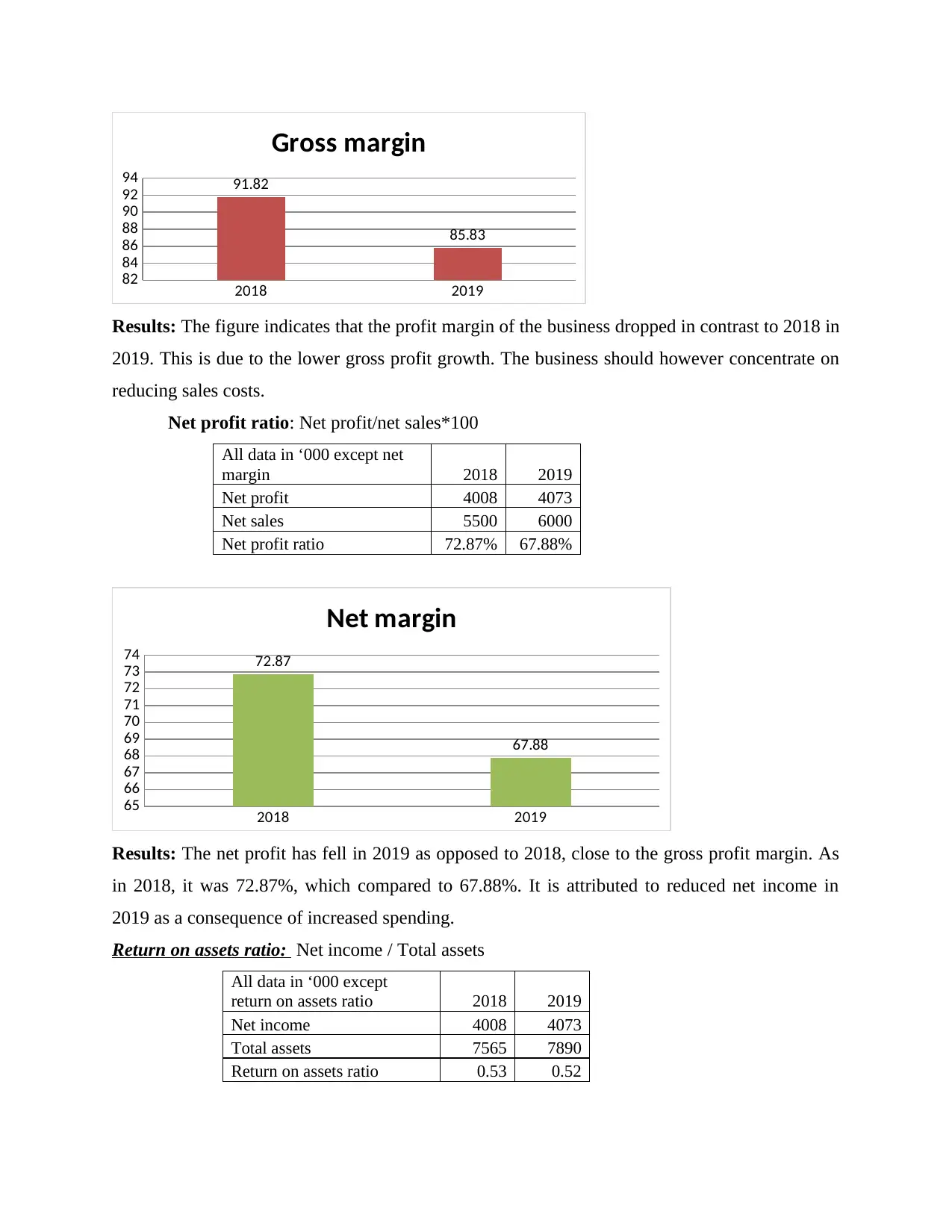
2018 2019
82
84
86
88
90
92
94 91.82
85.83
Gross margin
Results: The figure indicates that the profit margin of the business dropped in contrast to 2018 in
2019. This is due to the lower gross profit growth. The business should however concentrate on
reducing sales costs.
Net profit ratio: Net profit/net sales*100
All data in ‘000 except net
margin 2018 2019
Net profit 4008 4073
Net sales 5500 6000
Net profit ratio 72.87% 67.88%
2018 2019
65
66
67
68
69
70
71
72
73
74 72.87
67.88
Net margin
Results: The net profit has fell in 2019 as opposed to 2018, close to the gross profit margin. As
in 2018, it was 72.87%, which compared to 67.88%. It is attributed to reduced net income in
2019 as a consequence of increased spending.
Return on assets ratio: Net income / Total assets
All data in ‘000 except
return on assets ratio 2018 2019
Net income 4008 4073
Total assets 7565 7890
Return on assets ratio 0.53 0.52
82
84
86
88
90
92
94 91.82
85.83
Gross margin
Results: The figure indicates that the profit margin of the business dropped in contrast to 2018 in
2019. This is due to the lower gross profit growth. The business should however concentrate on
reducing sales costs.
Net profit ratio: Net profit/net sales*100
All data in ‘000 except net
margin 2018 2019
Net profit 4008 4073
Net sales 5500 6000
Net profit ratio 72.87% 67.88%
2018 2019
65
66
67
68
69
70
71
72
73
74 72.87
67.88
Net margin
Results: The net profit has fell in 2019 as opposed to 2018, close to the gross profit margin. As
in 2018, it was 72.87%, which compared to 67.88%. It is attributed to reduced net income in
2019 as a consequence of increased spending.
Return on assets ratio: Net income / Total assets
All data in ‘000 except
return on assets ratio 2018 2019
Net income 4008 4073
Total assets 7565 7890
Return on assets ratio 0.53 0.52
Paraphrase This Document
Need a fresh take? Get an instant paraphrase of this document with our AI Paraphraser

2018 2019
0.515
0.52
0.525
0.53
0.535 0.53
0.52
Return on assets
Results: For both years, the quality of the returns mostly on company's earnings is equal. Their
asset returns were 0.53 and 0.52 respectively in 2018 and 2019. Nonetheless, the business is not
even in the optimal state and will concentrate on improved assets operations.
Return on capital employed: Profit before interest and tax / capital employed
All data in ‘000 except
return on capital employed
ratio 2018 2019
Profit before interest and tax 5050 5150
Capital employed 6226 6274
Return on capital employed 0.81 0.82
2018 2019
0.804
0.806
0.808
0.81
0.812
0.814
0.816
0.818
0.82
0.822
0.81
0.82
ROE
Results: This business has improved the yield on the capital utilized percentage by a slight
amount. It was 0.81 in 2018 and 0.82 throughout 2019 like in 2018. It indicates that in 2019, the
business produces a strong return on its investments relative to 2018. Nevertheless, their level is
less than (> 1) and must be strengthened.
Liquidity ratio: This is a type of ratio that is calculated by businesses to determine the
liquidity for a defined time (Behkami, Gholami and Bakirdere, 2017). When utilizing this
formula, financial officers can quickly realize the worth of their available assets to cover
liabilities. The following are mentioned in the collection of various forms of ratios:
Current ratio: Current assets / current liabilities
0.515
0.52
0.525
0.53
0.535 0.53
0.52
Return on assets
Results: For both years, the quality of the returns mostly on company's earnings is equal. Their
asset returns were 0.53 and 0.52 respectively in 2018 and 2019. Nonetheless, the business is not
even in the optimal state and will concentrate on improved assets operations.
Return on capital employed: Profit before interest and tax / capital employed
All data in ‘000 except
return on capital employed
ratio 2018 2019
Profit before interest and tax 5050 5150
Capital employed 6226 6274
Return on capital employed 0.81 0.82
2018 2019
0.804
0.806
0.808
0.81
0.812
0.814
0.816
0.818
0.82
0.822
0.81
0.82
ROE
Results: This business has improved the yield on the capital utilized percentage by a slight
amount. It was 0.81 in 2018 and 0.82 throughout 2019 like in 2018. It indicates that in 2019, the
business produces a strong return on its investments relative to 2018. Nevertheless, their level is
less than (> 1) and must be strengthened.
Liquidity ratio: This is a type of ratio that is calculated by businesses to determine the
liquidity for a defined time (Behkami, Gholami and Bakirdere, 2017). When utilizing this
formula, financial officers can quickly realize the worth of their available assets to cover
liabilities. The following are mentioned in the collection of various forms of ratios:
Current ratio: Current assets / current liabilities

All data in ‘000
except current ratio
Year
2018
Year
2019
Current assets 1726 1624
Current liabilities 1339 1616
Current ratio
1.29
times
1.00
times
2018 2019
0
0.2
0.4
0.6
0.8
1
1.2
1.4 1.29
1
Current ratio
Results: The Company did not manage to maintain its existing proportion across both years at
such an optimal 2:1 ratio. The explanation is that they were 1.29 years, respectively, during the
year of 2018 and 2019. This shows that the Hotel has insufficient current assets to cover short-
term debts.
Quick ratio: Quick assets / current liabilities
All data in ‘000 except quick
ratio
Year
2018
Year
2019
Quick assets 276 204
Current liabilities 1339 1616
Quick ratio 0.21 0.13
2018 2019
0
0.05
0.1
0.15
0.2
0.25 0.21
0.13
Quick ratio
Results: The Corporation’s quick ratio is indeed smaller than that of the optimal 1.5:1 period’s
ratio. In 2018, the figure dropped by 0.21 times and therefore by 0.13 points in 2019. In order to
except current ratio
Year
2018
Year
2019
Current assets 1726 1624
Current liabilities 1339 1616
Current ratio
1.29
times
1.00
times
2018 2019
0
0.2
0.4
0.6
0.8
1
1.2
1.4 1.29
1
Current ratio
Results: The Company did not manage to maintain its existing proportion across both years at
such an optimal 2:1 ratio. The explanation is that they were 1.29 years, respectively, during the
year of 2018 and 2019. This shows that the Hotel has insufficient current assets to cover short-
term debts.
Quick ratio: Quick assets / current liabilities
All data in ‘000 except quick
ratio
Year
2018
Year
2019
Quick assets 276 204
Current liabilities 1339 1616
Quick ratio 0.21 0.13
2018 2019
0
0.05
0.1
0.15
0.2
0.25 0.21
0.13
Quick ratio
Results: The Corporation’s quick ratio is indeed smaller than that of the optimal 1.5:1 period’s
ratio. In 2018, the figure dropped by 0.21 times and therefore by 0.13 points in 2019. In order to
You're viewing a preview
Unlock full access by subscribing today!
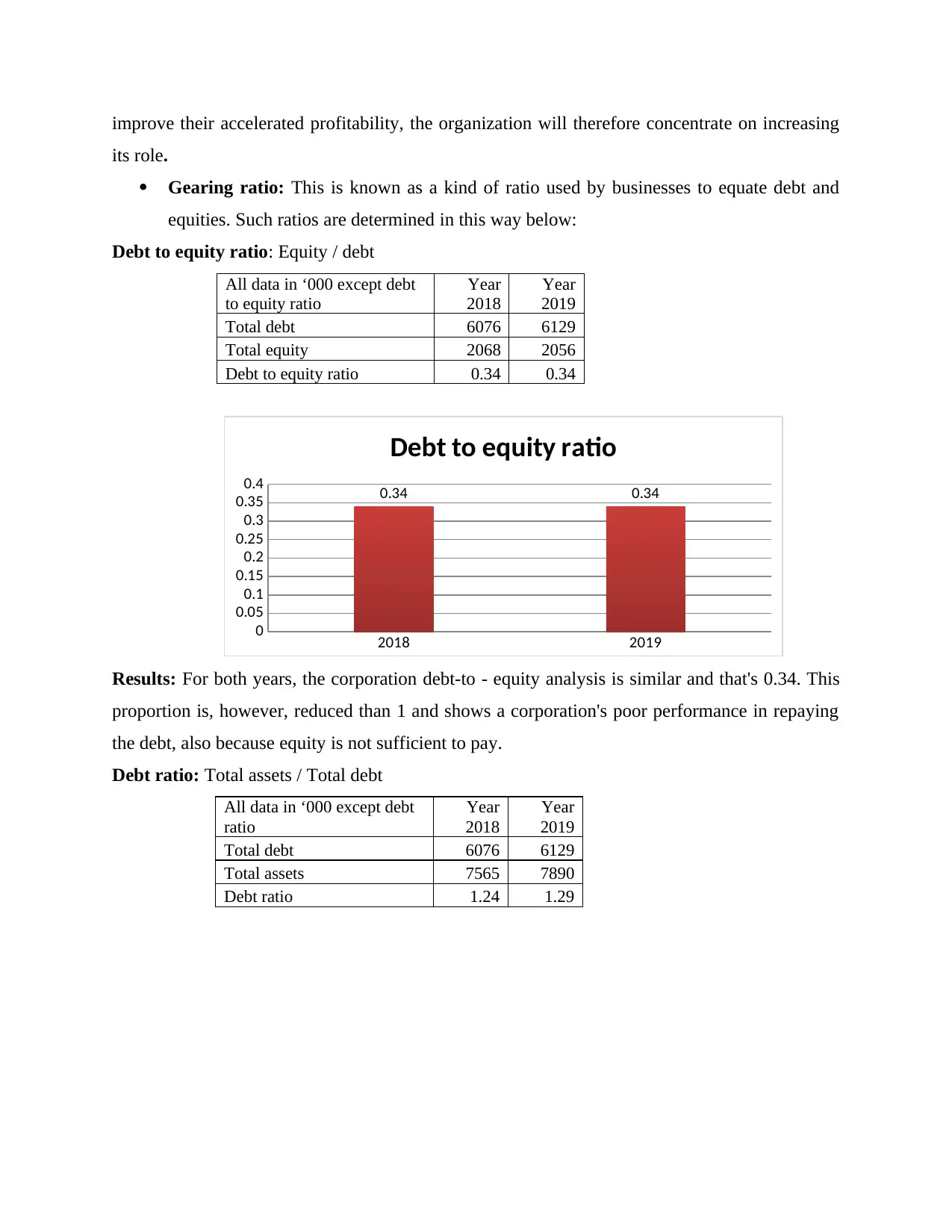
improve their accelerated profitability, the organization will therefore concentrate on increasing
its role.
Gearing ratio: This is known as a kind of ratio used by businesses to equate debt and
equities. Such ratios are determined in this way below:
Debt to equity ratio: Equity / debt
All data in ‘000 except debt
to equity ratio
Year
2018
Year
2019
Total debt 6076 6129
Total equity 2068 2056
Debt to equity ratio 0.34 0.34
2018 2019
0
0.05
0.1
0.15
0.2
0.25
0.3
0.35
0.4 0.34 0.34
Debt to equity ratio
Results: For both years, the corporation debt-to - equity analysis is similar and that's 0.34. This
proportion is, however, reduced than 1 and shows a corporation's poor performance in repaying
the debt, also because equity is not sufficient to pay.
Debt ratio: Total assets / Total debt
All data in ‘000 except debt
ratio
Year
2018
Year
2019
Total debt 6076 6129
Total assets 7565 7890
Debt ratio 1.24 1.29
its role.
Gearing ratio: This is known as a kind of ratio used by businesses to equate debt and
equities. Such ratios are determined in this way below:
Debt to equity ratio: Equity / debt
All data in ‘000 except debt
to equity ratio
Year
2018
Year
2019
Total debt 6076 6129
Total equity 2068 2056
Debt to equity ratio 0.34 0.34
2018 2019
0
0.05
0.1
0.15
0.2
0.25
0.3
0.35
0.4 0.34 0.34
Debt to equity ratio
Results: For both years, the corporation debt-to - equity analysis is similar and that's 0.34. This
proportion is, however, reduced than 1 and shows a corporation's poor performance in repaying
the debt, also because equity is not sufficient to pay.
Debt ratio: Total assets / Total debt
All data in ‘000 except debt
ratio
Year
2018
Year
2019
Total debt 6076 6129
Total assets 7565 7890
Debt ratio 1.24 1.29
Paraphrase This Document
Need a fresh take? Get an instant paraphrase of this document with our AI Paraphraser

2018 2019
1.21
1.22
1.23
1.24
1.25
1.26
1.27
1.28
1.29
1.3
1.24
1.29
Debt ratio
Results: The business leverage figure is in decent health as the organization requires enough
money to pay down its obligations. As in 2018, the proportion fell to 1,24 and increased to 1,29
in 2019. This indicates that in all financial years, the business has an outstanding financial
position to service its debts.
B) Ratio fluctuation useful for Hotel Management
The ratio study involves various forms of measures, each of which is crucial to the
interpretation of developments in a firm’s financial position. Throughout the above section, three
forms of factors, competitiveness, leverage and gearing ratio, were measured and evaluated. In
this case, the fundamental value of such ratios is discussed in relation to the aforementioned
Gastby Grange Hotel:
Ratio measurement and its variance have a significant function in the hospitality
management industry. This is because if an enterprise can detect variations in its business
results throughout 2 years, after which management measures can be applied
appropriately (Helmy and Arslan, 2018). As for the latter business Gatsby Grange,
various percentages are determined by means of the financial statements. Use these
percentages; manager will able determine the places of poor results. They could even
establish innovative weak spot management plans and tactics including for next year in
order to increase the profit margin and deliver best services under reasonable fees.
Therefore, the ratio evaluates plays an significant function for businesses in ensuring that
financial success is adequately measured in less time. For organizations to know their
1.21
1.22
1.23
1.24
1.25
1.26
1.27
1.28
1.29
1.3
1.24
1.29
Debt ratio
Results: The business leverage figure is in decent health as the organization requires enough
money to pay down its obligations. As in 2018, the proportion fell to 1,24 and increased to 1,29
in 2019. This indicates that in all financial years, the business has an outstanding financial
position to service its debts.
B) Ratio fluctuation useful for Hotel Management
The ratio study involves various forms of measures, each of which is crucial to the
interpretation of developments in a firm’s financial position. Throughout the above section, three
forms of factors, competitiveness, leverage and gearing ratio, were measured and evaluated. In
this case, the fundamental value of such ratios is discussed in relation to the aforementioned
Gastby Grange Hotel:
Ratio measurement and its variance have a significant function in the hospitality
management industry. This is because if an enterprise can detect variations in its business
results throughout 2 years, after which management measures can be applied
appropriately (Helmy and Arslan, 2018). As for the latter business Gatsby Grange,
various percentages are determined by means of the financial statements. Use these
percentages; manager will able determine the places of poor results. They could even
establish innovative weak spot management plans and tactics including for next year in
order to increase the profit margin and deliver best services under reasonable fees.
Therefore, the ratio evaluates plays an significant function for businesses in ensuring that
financial success is adequately measured in less time. For organizations to know their
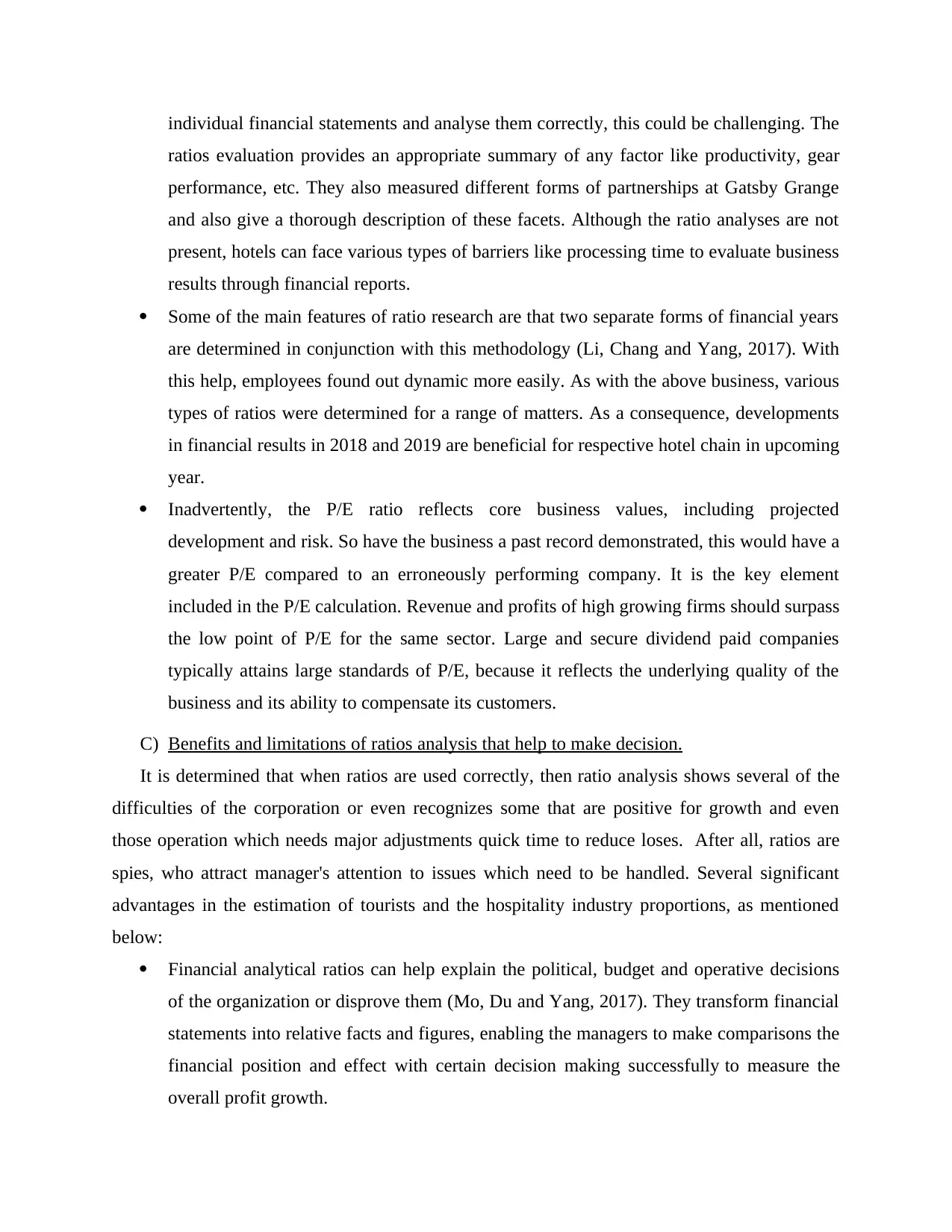
individual financial statements and analyse them correctly, this could be challenging. The
ratios evaluation provides an appropriate summary of any factor like productivity, gear
performance, etc. They also measured different forms of partnerships at Gatsby Grange
and also give a thorough description of these facets. Although the ratio analyses are not
present, hotels can face various types of barriers like processing time to evaluate business
results through financial reports.
Some of the main features of ratio research are that two separate forms of financial years
are determined in conjunction with this methodology (Li, Chang and Yang, 2017). With
this help, employees found out dynamic more easily. As with the above business, various
types of ratios were determined for a range of matters. As a consequence, developments
in financial results in 2018 and 2019 are beneficial for respective hotel chain in upcoming
year.
Inadvertently, the P/E ratio reflects core business values, including projected
development and risk. So have the business a past record demonstrated, this would have a
greater P/E compared to an erroneously performing company. It is the key element
included in the P/E calculation. Revenue and profits of high growing firms should surpass
the low point of P/E for the same sector. Large and secure dividend paid companies
typically attains large standards of P/E, because it reflects the underlying quality of the
business and its ability to compensate its customers.
C) Benefits and limitations of ratios analysis that help to make decision.
It is determined that when ratios are used correctly, then ratio analysis shows several of the
difficulties of the corporation or even recognizes some that are positive for growth and even
those operation which needs major adjustments quick time to reduce loses. After all, ratios are
spies, who attract manager's attention to issues which need to be handled. Several significant
advantages in the estimation of tourists and the hospitality industry proportions, as mentioned
below:
Financial analytical ratios can help explain the political, budget and operative decisions
of the organization or disprove them (Mo, Du and Yang, 2017). They transform financial
statements into relative facts and figures, enabling the managers to make comparisons the
financial position and effect with certain decision making successfully to measure the
overall profit growth.
ratios evaluation provides an appropriate summary of any factor like productivity, gear
performance, etc. They also measured different forms of partnerships at Gatsby Grange
and also give a thorough description of these facets. Although the ratio analyses are not
present, hotels can face various types of barriers like processing time to evaluate business
results through financial reports.
Some of the main features of ratio research are that two separate forms of financial years
are determined in conjunction with this methodology (Li, Chang and Yang, 2017). With
this help, employees found out dynamic more easily. As with the above business, various
types of ratios were determined for a range of matters. As a consequence, developments
in financial results in 2018 and 2019 are beneficial for respective hotel chain in upcoming
year.
Inadvertently, the P/E ratio reflects core business values, including projected
development and risk. So have the business a past record demonstrated, this would have a
greater P/E compared to an erroneously performing company. It is the key element
included in the P/E calculation. Revenue and profits of high growing firms should surpass
the low point of P/E for the same sector. Large and secure dividend paid companies
typically attains large standards of P/E, because it reflects the underlying quality of the
business and its ability to compensate its customers.
C) Benefits and limitations of ratios analysis that help to make decision.
It is determined that when ratios are used correctly, then ratio analysis shows several of the
difficulties of the corporation or even recognizes some that are positive for growth and even
those operation which needs major adjustments quick time to reduce loses. After all, ratios are
spies, who attract manager's attention to issues which need to be handled. Several significant
advantages in the estimation of tourists and the hospitality industry proportions, as mentioned
below:
Financial analytical ratios can help explain the political, budget and operative decisions
of the organization or disprove them (Mo, Du and Yang, 2017). They transform financial
statements into relative facts and figures, enabling the managers to make comparisons the
financial position and effect with certain decision making successfully to measure the
overall profit growth.
You're viewing a preview
Unlock full access by subscribing today!
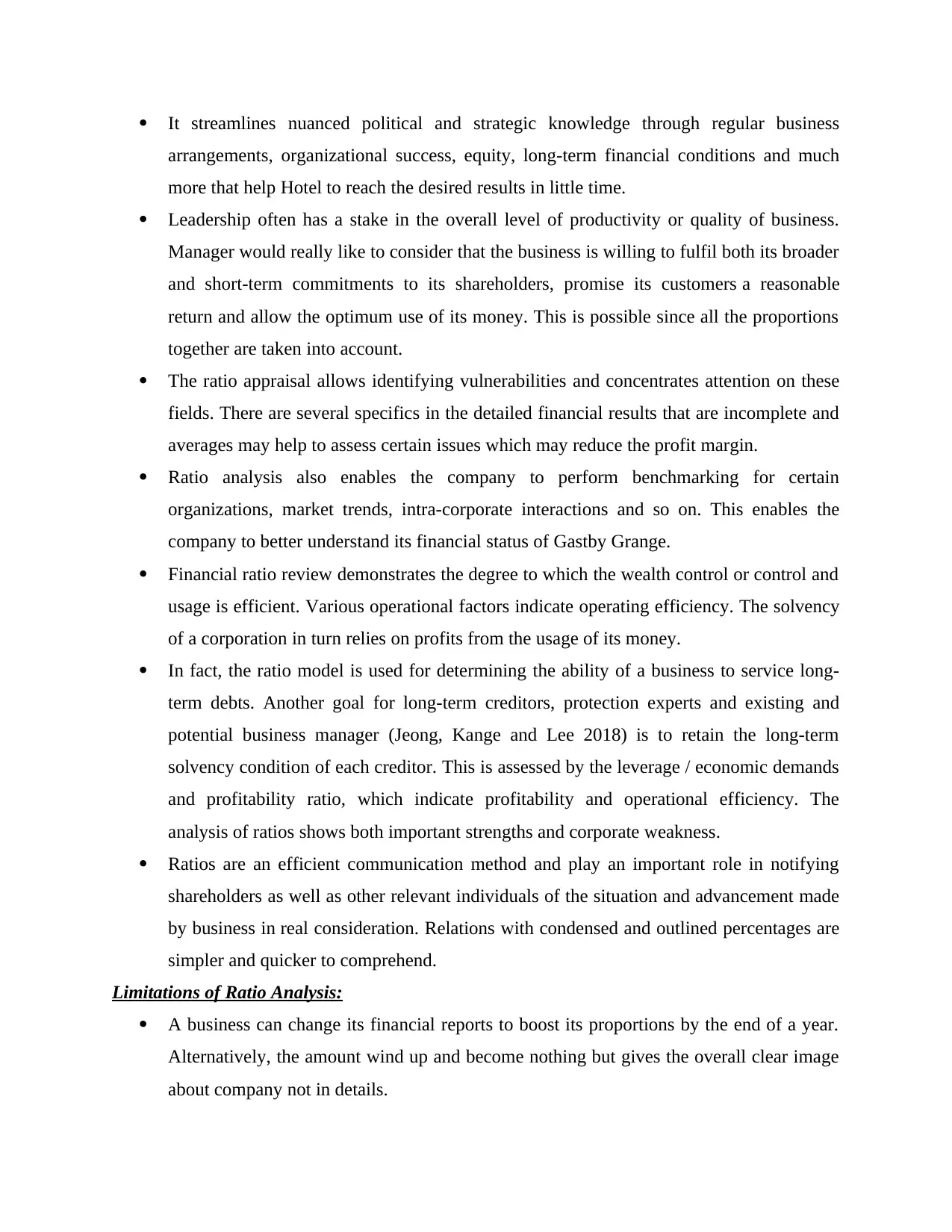
It streamlines nuanced political and strategic knowledge through regular business
arrangements, organizational success, equity, long-term financial conditions and much
more that help Hotel to reach the desired results in little time.
Leadership often has a stake in the overall level of productivity or quality of business.
Manager would really like to consider that the business is willing to fulfil both its broader
and short-term commitments to its shareholders, promise its customers a reasonable
return and allow the optimum use of its money. This is possible since all the proportions
together are taken into account.
The ratio appraisal allows identifying vulnerabilities and concentrates attention on these
fields. There are several specifics in the detailed financial results that are incomplete and
averages may help to assess certain issues which may reduce the profit margin.
Ratio analysis also enables the company to perform benchmarking for certain
organizations, market trends, intra-corporate interactions and so on. This enables the
company to better understand its financial status of Gastby Grange.
Financial ratio review demonstrates the degree to which the wealth control or control and
usage is efficient. Various operational factors indicate operating efficiency. The solvency
of a corporation in turn relies on profits from the usage of its money.
In fact, the ratio model is used for determining the ability of a business to service long-
term debts. Another goal for long-term creditors, protection experts and existing and
potential business manager (Jeong, Kange and Lee 2018) is to retain the long-term
solvency condition of each creditor. This is assessed by the leverage / economic demands
and profitability ratio, which indicate profitability and operational efficiency. The
analysis of ratios shows both important strengths and corporate weakness.
Ratios are an efficient communication method and play an important role in notifying
shareholders as well as other relevant individuals of the situation and advancement made
by business in real consideration. Relations with condensed and outlined percentages are
simpler and quicker to comprehend.
Limitations of Ratio Analysis:
A business can change its financial reports to boost its proportions by the end of a year.
Alternatively, the amount wind up and become nothing but gives the overall clear image
about company not in details.
arrangements, organizational success, equity, long-term financial conditions and much
more that help Hotel to reach the desired results in little time.
Leadership often has a stake in the overall level of productivity or quality of business.
Manager would really like to consider that the business is willing to fulfil both its broader
and short-term commitments to its shareholders, promise its customers a reasonable
return and allow the optimum use of its money. This is possible since all the proportions
together are taken into account.
The ratio appraisal allows identifying vulnerabilities and concentrates attention on these
fields. There are several specifics in the detailed financial results that are incomplete and
averages may help to assess certain issues which may reduce the profit margin.
Ratio analysis also enables the company to perform benchmarking for certain
organizations, market trends, intra-corporate interactions and so on. This enables the
company to better understand its financial status of Gastby Grange.
Financial ratio review demonstrates the degree to which the wealth control or control and
usage is efficient. Various operational factors indicate operating efficiency. The solvency
of a corporation in turn relies on profits from the usage of its money.
In fact, the ratio model is used for determining the ability of a business to service long-
term debts. Another goal for long-term creditors, protection experts and existing and
potential business manager (Jeong, Kange and Lee 2018) is to retain the long-term
solvency condition of each creditor. This is assessed by the leverage / economic demands
and profitability ratio, which indicate profitability and operational efficiency. The
analysis of ratios shows both important strengths and corporate weakness.
Ratios are an efficient communication method and play an important role in notifying
shareholders as well as other relevant individuals of the situation and advancement made
by business in real consideration. Relations with condensed and outlined percentages are
simpler and quicker to comprehend.
Limitations of Ratio Analysis:
A business can change its financial reports to boost its proportions by the end of a year.
Alternatively, the amount wind up and become nothing but gives the overall clear image
about company not in details.
Paraphrase This Document
Need a fresh take? Get an instant paraphrase of this document with our AI Paraphraser
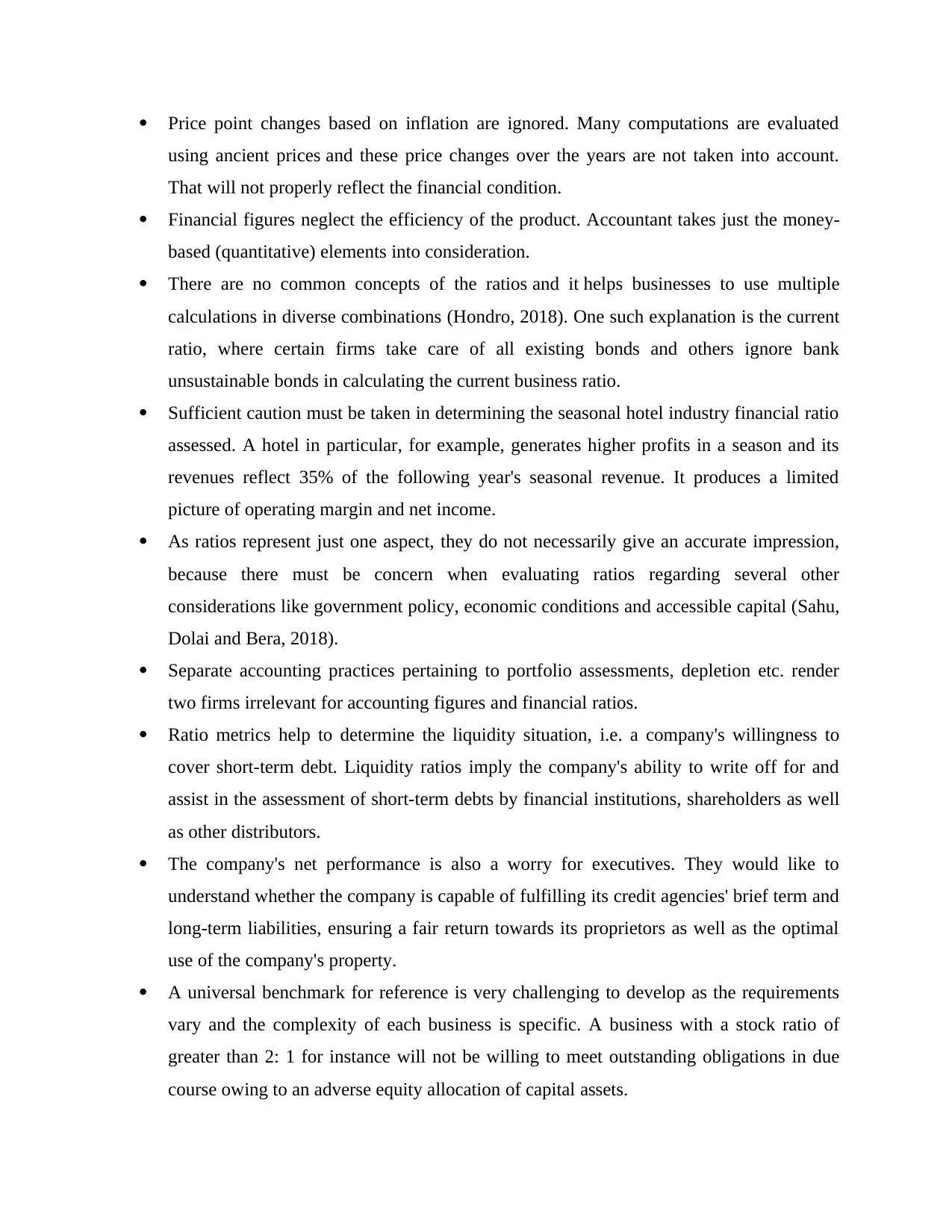
Price point changes based on inflation are ignored. Many computations are evaluated
using ancient prices and these price changes over the years are not taken into account.
That will not properly reflect the financial condition.
Financial figures neglect the efficiency of the product. Accountant takes just the money-
based (quantitative) elements into consideration.
There are no common concepts of the ratios and it helps businesses to use multiple
calculations in diverse combinations (Hondro, 2018). One such explanation is the current
ratio, where certain firms take care of all existing bonds and others ignore bank
unsustainable bonds in calculating the current business ratio.
Sufficient caution must be taken in determining the seasonal hotel industry financial ratio
assessed. A hotel in particular, for example, generates higher profits in a season and its
revenues reflect 35% of the following year's seasonal revenue. It produces a limited
picture of operating margin and net income.
As ratios represent just one aspect, they do not necessarily give an accurate impression,
because there must be concern when evaluating ratios regarding several other
considerations like government policy, economic conditions and accessible capital (Sahu,
Dolai and Bera, 2018).
Separate accounting practices pertaining to portfolio assessments, depletion etc. render
two firms irrelevant for accounting figures and financial ratios.
Ratio metrics help to determine the liquidity situation, i.e. a company's willingness to
cover short-term debt. Liquidity ratios imply the company's ability to write off for and
assist in the assessment of short-term debts by financial institutions, shareholders as well
as other distributors.
The company's net performance is also a worry for executives. They would like to
understand whether the company is capable of fulfilling its credit agencies' brief term and
long-term liabilities, ensuring a fair return towards its proprietors as well as the optimal
use of the company's property.
A universal benchmark for reference is very challenging to develop as the requirements
vary and the complexity of each business is specific. A business with a stock ratio of
greater than 2: 1 for instance will not be willing to meet outstanding obligations in due
course owing to an adverse equity allocation of capital assets.
using ancient prices and these price changes over the years are not taken into account.
That will not properly reflect the financial condition.
Financial figures neglect the efficiency of the product. Accountant takes just the money-
based (quantitative) elements into consideration.
There are no common concepts of the ratios and it helps businesses to use multiple
calculations in diverse combinations (Hondro, 2018). One such explanation is the current
ratio, where certain firms take care of all existing bonds and others ignore bank
unsustainable bonds in calculating the current business ratio.
Sufficient caution must be taken in determining the seasonal hotel industry financial ratio
assessed. A hotel in particular, for example, generates higher profits in a season and its
revenues reflect 35% of the following year's seasonal revenue. It produces a limited
picture of operating margin and net income.
As ratios represent just one aspect, they do not necessarily give an accurate impression,
because there must be concern when evaluating ratios regarding several other
considerations like government policy, economic conditions and accessible capital (Sahu,
Dolai and Bera, 2018).
Separate accounting practices pertaining to portfolio assessments, depletion etc. render
two firms irrelevant for accounting figures and financial ratios.
Ratio metrics help to determine the liquidity situation, i.e. a company's willingness to
cover short-term debt. Liquidity ratios imply the company's ability to write off for and
assist in the assessment of short-term debts by financial institutions, shareholders as well
as other distributors.
The company's net performance is also a worry for executives. They would like to
understand whether the company is capable of fulfilling its credit agencies' brief term and
long-term liabilities, ensuring a fair return towards its proprietors as well as the optimal
use of the company's property.
A universal benchmark for reference is very challenging to develop as the requirements
vary and the complexity of each business is specific. A business with a stock ratio of
greater than 2: 1 for instance will not be willing to meet outstanding obligations in due
course owing to an adverse equity allocation of capital assets.
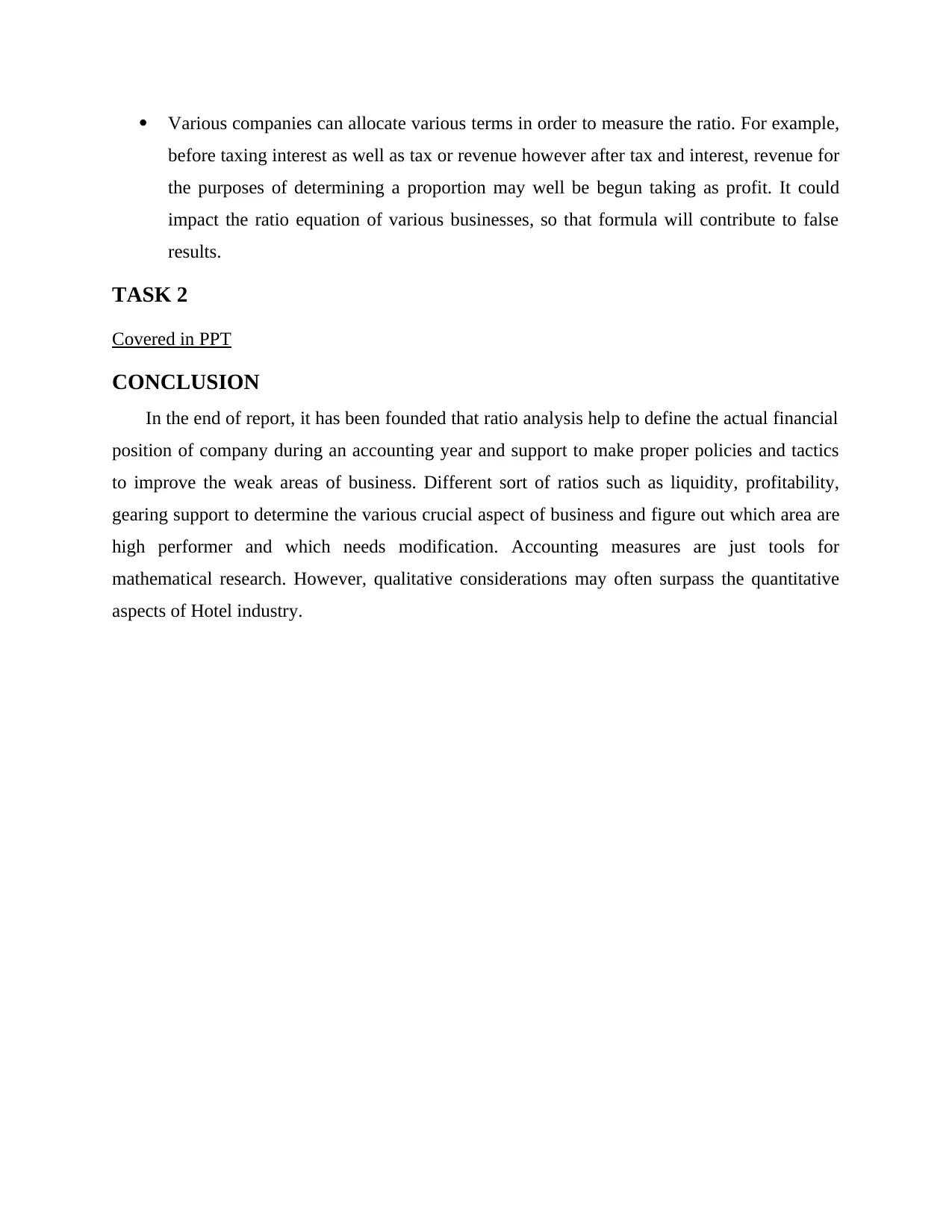
Various companies can allocate various terms in order to measure the ratio. For example,
before taxing interest as well as tax or revenue however after tax and interest, revenue for
the purposes of determining a proportion may well be begun taking as profit. It could
impact the ratio equation of various businesses, so that formula will contribute to false
results.
TASK 2
Covered in PPT
CONCLUSION
In the end of report, it has been founded that ratio analysis help to define the actual financial
position of company during an accounting year and support to make proper policies and tactics
to improve the weak areas of business. Different sort of ratios such as liquidity, profitability,
gearing support to determine the various crucial aspect of business and figure out which area are
high performer and which needs modification. Accounting measures are just tools for
mathematical research. However, qualitative considerations may often surpass the quantitative
aspects of Hotel industry.
before taxing interest as well as tax or revenue however after tax and interest, revenue for
the purposes of determining a proportion may well be begun taking as profit. It could
impact the ratio equation of various businesses, so that formula will contribute to false
results.
TASK 2
Covered in PPT
CONCLUSION
In the end of report, it has been founded that ratio analysis help to define the actual financial
position of company during an accounting year and support to make proper policies and tactics
to improve the weak areas of business. Different sort of ratios such as liquidity, profitability,
gearing support to determine the various crucial aspect of business and figure out which area are
high performer and which needs modification. Accounting measures are just tools for
mathematical research. However, qualitative considerations may often surpass the quantitative
aspects of Hotel industry.
You're viewing a preview
Unlock full access by subscribing today!
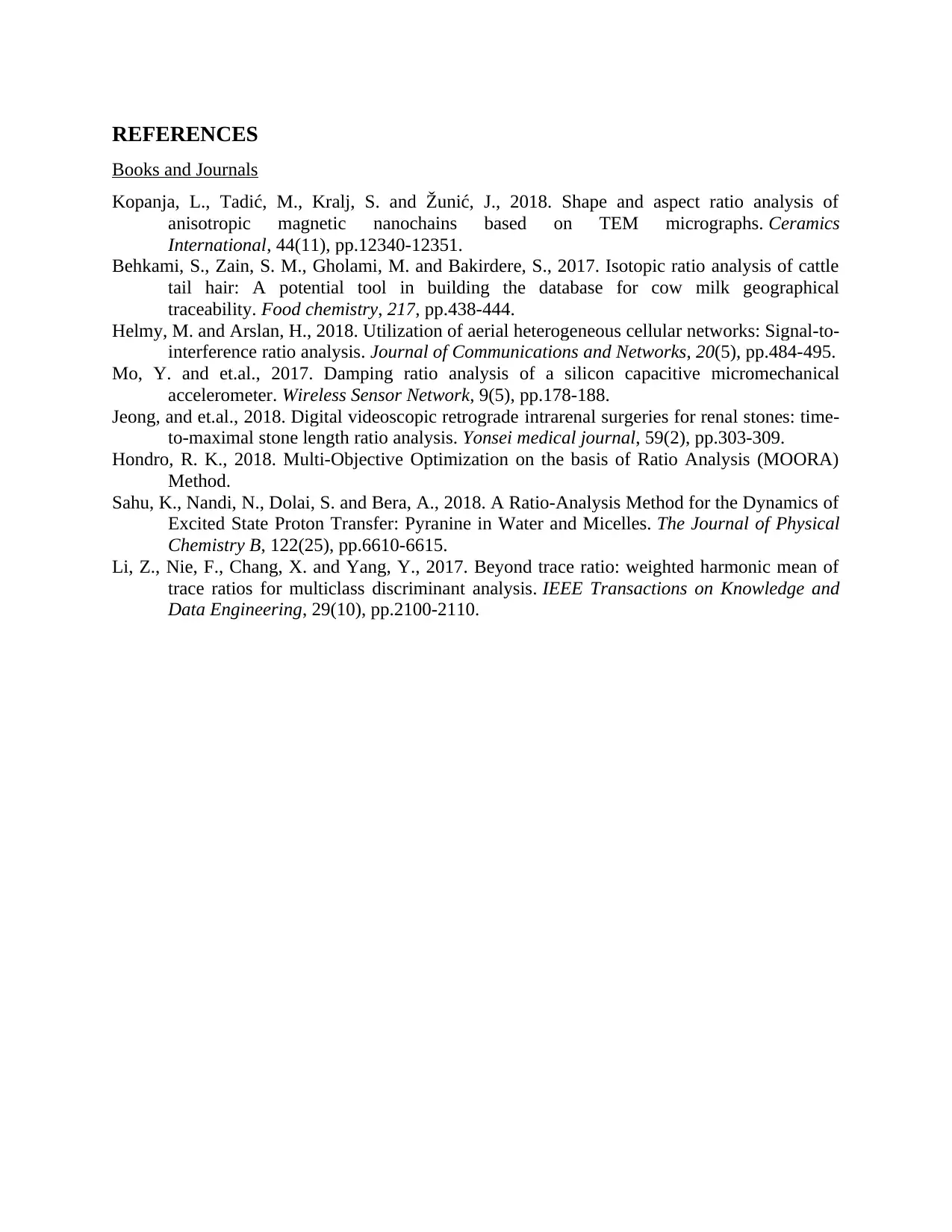
REFERENCES
Books and Journals
Kopanja, L., Tadić, M., Kralj, S. and Žunić, J., 2018. Shape and aspect ratio analysis of
anisotropic magnetic nanochains based on TEM micrographs. Ceramics
International, 44(11), pp.12340-12351.
Behkami, S., Zain, S. M., Gholami, M. and Bakirdere, S., 2017. Isotopic ratio analysis of cattle
tail hair: A potential tool in building the database for cow milk geographical
traceability. Food chemistry, 217, pp.438-444.
Helmy, M. and Arslan, H., 2018. Utilization of aerial heterogeneous cellular networks: Signal-to-
interference ratio analysis. Journal of Communications and Networks, 20(5), pp.484-495.
Mo, Y. and et.al., 2017. Damping ratio analysis of a silicon capacitive micromechanical
accelerometer. Wireless Sensor Network, 9(5), pp.178-188.
Jeong, and et.al., 2018. Digital videoscopic retrograde intrarenal surgeries for renal stones: time-
to-maximal stone length ratio analysis. Yonsei medical journal, 59(2), pp.303-309.
Hondro, R. K., 2018. Multi-Objective Optimization on the basis of Ratio Analysis (MOORA)
Method.
Sahu, K., Nandi, N., Dolai, S. and Bera, A., 2018. A Ratio-Analysis Method for the Dynamics of
Excited State Proton Transfer: Pyranine in Water and Micelles. The Journal of Physical
Chemistry B, 122(25), pp.6610-6615.
Li, Z., Nie, F., Chang, X. and Yang, Y., 2017. Beyond trace ratio: weighted harmonic mean of
trace ratios for multiclass discriminant analysis. IEEE Transactions on Knowledge and
Data Engineering, 29(10), pp.2100-2110.
Books and Journals
Kopanja, L., Tadić, M., Kralj, S. and Žunić, J., 2018. Shape and aspect ratio analysis of
anisotropic magnetic nanochains based on TEM micrographs. Ceramics
International, 44(11), pp.12340-12351.
Behkami, S., Zain, S. M., Gholami, M. and Bakirdere, S., 2017. Isotopic ratio analysis of cattle
tail hair: A potential tool in building the database for cow milk geographical
traceability. Food chemistry, 217, pp.438-444.
Helmy, M. and Arslan, H., 2018. Utilization of aerial heterogeneous cellular networks: Signal-to-
interference ratio analysis. Journal of Communications and Networks, 20(5), pp.484-495.
Mo, Y. and et.al., 2017. Damping ratio analysis of a silicon capacitive micromechanical
accelerometer. Wireless Sensor Network, 9(5), pp.178-188.
Jeong, and et.al., 2018. Digital videoscopic retrograde intrarenal surgeries for renal stones: time-
to-maximal stone length ratio analysis. Yonsei medical journal, 59(2), pp.303-309.
Hondro, R. K., 2018. Multi-Objective Optimization on the basis of Ratio Analysis (MOORA)
Method.
Sahu, K., Nandi, N., Dolai, S. and Bera, A., 2018. A Ratio-Analysis Method for the Dynamics of
Excited State Proton Transfer: Pyranine in Water and Micelles. The Journal of Physical
Chemistry B, 122(25), pp.6610-6615.
Li, Z., Nie, F., Chang, X. and Yang, Y., 2017. Beyond trace ratio: weighted harmonic mean of
trace ratios for multiclass discriminant analysis. IEEE Transactions on Knowledge and
Data Engineering, 29(10), pp.2100-2110.
1 out of 13
Related Documents
Your All-in-One AI-Powered Toolkit for Academic Success.
+13062052269
info@desklib.com
Available 24*7 on WhatsApp / Email
![[object Object]](/_next/static/media/star-bottom.7253800d.svg)
Unlock your academic potential
© 2024 | Zucol Services PVT LTD | All rights reserved.





